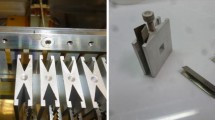Abstract
Calibration of 6Li enriched spike by Reverse IDMS was carried out by monitoring molecular ion species NaLiBO2+ at m/z 71, 72 and 73 together with Na2BO2+ at m/z 88 and 89. Two independent 6Li/7Li ratios were obtained from two ion intensity ratios, 73I/71I and 72I/73I and the concentration values for lithium determined using these two ratios were in close agreement with each other. The use of heavier molecular ions resulted in a precision of better than 0.1% for the concentration of lithium in 6Li spike determined by R-IDMS and 7Li enriched solution of Li2CO3 determined using the pre-calibrated 6Li spike.


Similar content being viewed by others
References
https://www.world-nuclear.org/information-library/current-and-future-generation/lithium.aspx (2017)
Tim A et al (2012) Lithium Isotope Enrichment: Feasible Domestic Enrichment Alternatives. Department of Nuclear Engineering University of California, Berkeley
A. Long, et al. (2002) Automatic control of the lithium concentration of the reactor coolant in PWR plants. https://inis.iaea.org/collection/NCLCollectionStore/Public/34/057/3 4057643.pdf
Sood DD (2009) Molten salt reactors fuel, IANCAS Bulletin 137–150
Mandal D et al (2010) Synthesis & fabrication of lithium-titanate pebbles for ITER breeding blanket by solid state reaction & spherodization. Fusion Eng Des 85:819–823
Knitter R et al (2012) Synthesis of tritium breeder ceramics from metallic lithium. J Nucl Mater 420:268–272
Chhillar S et al (2015) Compositional characterization of lithium titanate ceramic samples by determining Li, Ti and O concentrations simultaneously using PIGE at 8 MeV proton beam. J Radioanal Nucl Chem 305:463–467
Erdtmann G, Kroner B (1986) Determination of lithium in graphite by neutron activation analysis. J Radioanal Nucl Chem Art 113:317–326
Barba A et al (2002) Microwave-assisted digestion of ceramic frits for boron and lithium determination by inductively coupled plasma spectrometry (ICP-OES). Glass Sci Technol 75(5):254–258
Vanhoen H (1991) Determination of lithium in biological samples by inductively coupled plasma mass spectrometry. Anal Chim Acta 244:259–261
Teng F-Z et al (2004) Lithium isotopic composition and concentration of the upper continental crust. Geochim Cosmochim Acta 68(20):4167–4178
Lamberty A, De Bievre P (1991) Isotope dilution mass spectrometry of l0B and 6LiF reference deposits used for the determination of the neutron lifetime. Int J Mass Spectrom and Ion Proc 108:189–198
Lamberty A, De Bievre P (1993) CBNM - determination of Li in BCR reference materials RM 303 and RM 304 lyophilized serum by isotope dilution mass spectrometry (IDMS). Fresenius J Anal Chem 345:330–334
Heumann KG (1992) Isotope dilution mass spectrometry (IDMS) of the elements. Mass Spectrom Rev 11:41–67
Nishio Y et al (2002) Accurate and precise lithium isotopic determinations of igneous rock samples using multi-collector inductively coupled plasma mass spectrometry. Anal Chim Acta 456:271–281
Lin J et al (2016) Accurate determination of lithium isotope ratios by MC-ICP-MS without strict matrix-matching by using a novel washing method. J Anal At Spectrom 31:390–397
Takuya Moriguti and Eizo Nakamura (1998) High-yield lithium separation and the precise isotopic analysis for natural rock and aqueous samples. Chem Geol 145:91–104
Datta BP et al (1992) Thermal ionisation mass spectrometry of Li2BO2+ ions: determination of the isotopic abundance ratio of lithium. Int J Mass Spectrom and Ion Processes 116:87–114
Rao RM et al (2020) Precise and rapid isotopic analysis of lithium in refractory materials using NaLiBO2+ by thermal ionization mass spectrometry (TIMS). Int J Mass Spectrom 451:116292
Lamberty A, De Bievre P (1988) An enriched 6Li isotope reference material. Int J Mass Spectrom Ion Processes 83:135–145
Moriguti T et al (2004) Determination of lithium contents in silicates by isotope dilution ICP-MS and its evaluation by isotope dilution thermal ionisation mass spectrometry. Geostand Geoanal Res 28:371–382
Aggarwal SK, Jain HC (1995) Polyatomic ions in thermal ionisation mass spectrometry-challenges and opportunities. Int J Mass Spectrom and Ion Processes 141:149–160
Datta BP et al (1995) Isotopic analysis of a 6Li enriched lithium sample employing the Li2BO2+ ion beam method: verification of the theoretical accuracy. Int J Mass Spectrom and Ion Processes 142:69–81
Sasi Bhushan K et al (2016) Simultaneous determination of non-natural isotopic composition of Li and B employing Li2BO2+ by Thermal Ionisation Mass Spectrometry. Int J Mass Spectrom 406:20–28
Acknowledgements
The authors express their sincere thanks to Mr. SandeepViswasrao and Mr. Rajesh Jadhav of Equipment Electronics Service Section, of RC &I Group for their prompt troubleshooting services, Dr. S. Kannan, Head, Fuel Chemistry Division, and Dr. P.G. Jaison, Head Mass Spectrometry Section for their encouragement and support. Authors also express their gratitude to the peer reviewers for their valuable suggestions to bring this manuscript into a well-structured format.
Author information
Authors and Affiliations
Corresponding author
Additional information
Publisher's Note
Springer Nature remains neutral with regard to jurisdictional claims in published maps and institutional affiliations.
Appendix: Error propagation during calibration of spike by IDMS
Appendix: Error propagation during calibration of spike by IDMS
Rsp, Rstd and RM are the observed 6Li/7Li isotope ratios in the spike, standard and blend of standard + spike respectively, At.Wt. denotes average atomic weight of Lithium in standard or enriched isotope and A.F. denotes atomic fraction of the isotope in spike and standard.
The contribution of various terms in the IDMS equation to the total uncertainty in the concentration of lithium in the spike solution (Tables 6 and 7).
Uncertainty in the concentration of lithium in Li2CO3 (ustd) = √ u12 + u22 + u32 = 0.037%.
Rights and permissions
About this article
Cite this article
Bhushan, K.S., Goswami, P.G. & Rao, R.M. Isotope dilution thermal ionization mass spectrometry (ID-TIMS) for determination of concentration of enriched lithium using NaLiBO2+ ions. J Radioanal Nucl Chem 326, 1009–1017 (2020). https://doi.org/10.1007/s10967-020-07409-w
Received:
Accepted:
Published:
Issue Date:
DOI: https://doi.org/10.1007/s10967-020-07409-w




